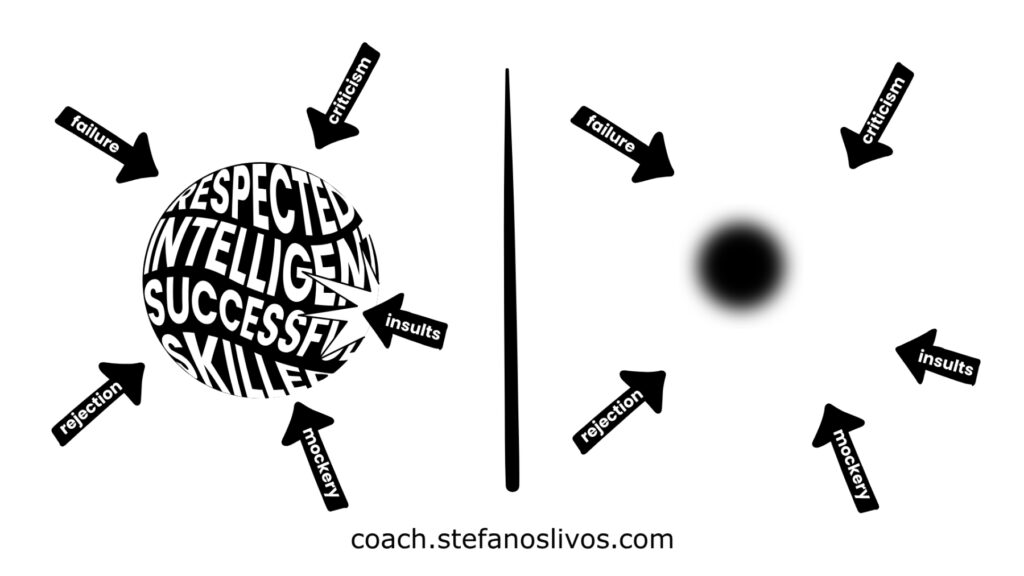Summary:
- The post discusses the concept of the “fluid ego-self”, emphasizing that our emotions, thoughts, and behaviors are constantly evolving, influenced by circumstances and surroundings.
- Accepting that their ego-self is fluid can help leaders and others overcome self-limiting beliefs, improve decision making and change management.
- Cultivating this mindset among leaders can lead to an organizational culture that welcomes change and innovation.
My previous post discussed the notion that there is no enduring ego-self as we continually evolve. Our emotions, thoughts, behaviors, values, and beliefs are in perpetual motion, shaped by circumstances and surroundings. The labels we use to describe ourselves are, in essence, mere approximations. This understanding, deeply rooted in Eastern philosophy and now substantiated by neuroscience, can benefit all individuals, especially leaders. Here are five reasons why.
Breaking free from self-beliefs and self-limitations
Before I discovered that optimism is a skill, I believed I was pessimistic. I viewed it as an integral part of my true self, causing me to miss out on opportunities. This became a limiting belief, leading to self-fulfilling prophecies. Indeed, research by Dr. Carol Dweck at Stanford University has shown that individuals with a fixed mindset, believing their abilities to be static, often underperform compared to those with a growth mindset, who believe they can develop their skills over time. When we categorize ourselves and others based on fixed labels, we inadvertently impose constraints on our potential, hindering personal and professional growth.
Consider a scenario where someone doubts our skills in a particular area. Our instinctive reaction is to defend our self-image, which is nothing but the labels we assign to ourselves. The more labels we attach, the larger our ego-self becomes, making it more vulnerable to external opinions. In contrast, a modest, fluid ego-self remains adaptive and resilient. It drives us towards our goals without being derailed by outside perspectives.

Leaders who comprehend the fluidity of the ego recognize that labels represent a person only at a specific moment and in a particular context. Such leaders continuously challenge both their own and their team’s perceived self-beliefs and limitations, creating a conducive environment for growth.
Applying empathy for a harmonious environment
Empathy has rightfully become a cornerstone of effective leadership. However, it can be compromised by rigid self-beliefs. For instance, a leader who identifies as fiercely coompetitive might, due to this fixed self-perception, perceive colleagues as adversaries instead of allies, undermining collaboration. This can hinder their ability to show empathy and compassion when needed.
Leaders attuned to the fluid nature of the self appreciate that behavior varies with circumstances. This realization enables them to empathize when things go awry, acknowledging that everyone’s actions are influenced by external factors and context. Consequently, they tend to cultivate a harmonious and productive workspace.
Managing emotions in decision making
Decision making is one of the most critical leadership skills. Contrary to the popular belief that we can make strictly rational decisions, modern neuroscience tells us that our emotions play a big role in how we make decisions. In our interaction with the world, the parts of our brain that deal with emotions kick in before the ones for logical thinking. So, our emotions often come into play before we start thinking logically.
Leaders who embrace the idea of a flexible self have a mindset for growth. They stay open to different perspectives and pay attention to their emotions, so they can tell when they might be acting too quickly, carelessly, or selfishly. They also get good at spotting these traits in others. Their self-awareness and self-regulation (both parts of emotional intelligence), combined with open thinking, usually lead to better decision-making.
Navigating change with adaptability
In our constantly changing world, being adaptable is crucial. Leaders who are stuck in a rigid self-image, acting entitled and saying, “This is how I do things,” often have a hard time dealing with unexpected challenges or changes in the workplace.
On the other hand, leaders who understand the idea of a flexible self are ready to adapt. They don’t cling to outdated ideas and can easily change course to guide their teams through tough times. They don’t hold onto old ways of thinking about themselves because they know that every situation requires a unique response that fits the circumstances.
Handling conflict with nuance
A clear grasp of the flexible ego-self concept gives leaders a unique way to approach conflicts. Instead of labeling people based on one action, they avoid making snap judgments about someone’s character. They understand that human behavior can change and adapt.
This idea is in line with the fundamental attribution error, a cognitive bias which suggests that actions don’t always reflect a person’s true character but can be influenced by the situation. With this understanding, leaders approach conflicts with more empathy and patience, trying to address the underlying causes instead of making quick judgments about people.
Conclusion
Leaders have a duty not only to guide others, but also guide themselves towards ongoing growth and self-discovery. When they fully accept the idea of the fluid ego-self, they can improve their ability to adapt, empathize, resolve conflicts, and make decisions, all while reducing rigid beliefs and self-fulfilling predictions. This creates a dynamic organizational culture that prioritizes employee wellbeing, and embraces change and innovation.
In the next post, we will talk about how leaders cab do this in practice.
